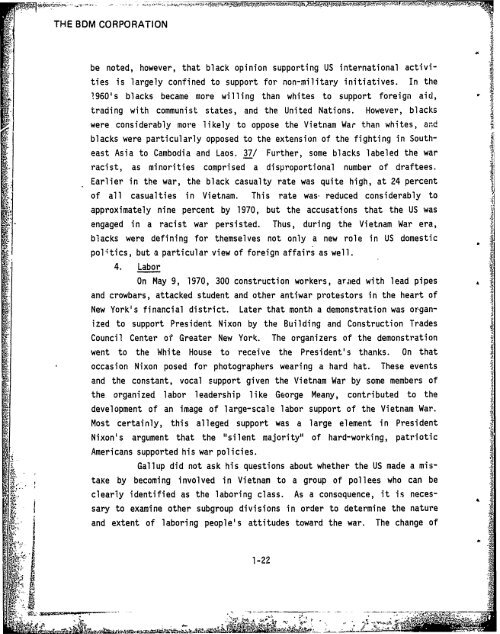policy - The Black Vault
policy - The Black Vault
policy - The Black Vault
You also want an ePaper? Increase the reach of your titles
YUMPU automatically turns print PDFs into web optimized ePapers that Google loves.
THE BDM CORPORATION<br />
be noted, however, that black opinion supporting US<br />
international activities<br />
is largely confined to support for non-military initiatives.<br />
1960's blacks became<br />
In the<br />
more willing than whites to support foreign aid,<br />
trading with communist states, and the United Nations. However, blacks<br />
were considerably more likely to oppose the Vietnam War than whites, and<br />
blacks were particularly opposed to the extension of the fighting in Southeast<br />
Asia to Cambodia and Laos. 37/ Further, some blacks labeled the war<br />
racist, as minorities comprised a disproportional number of draftees.<br />
Earlier in the war,<br />
the black casualty rate was quite high, at 24 percent<br />
of all casualties in Vietnam. This rate was. reduced considerably to<br />
approximately nine percent by 1970, but the accusations that the US was<br />
engaged in a racist war persisted. Thus, during the Vietnam War era,<br />
blacks were defining for themselves not only a new role in US domestic<br />
politics, but a particular view of foreign affairs as well.<br />
4. Labor<br />
and crowbars,<br />
On May 9, 1970, 300 construction workers, ar,;ied with lead pipes<br />
attacked student and other antiwar protestors in the heart of<br />
New York's financial district. Later that month a demonstration was organized<br />
to support President Nixon by the Building and Construction Trades<br />
Council Center of Greater New York.<br />
<strong>The</strong> organizers of the demonstration<br />
went to the White House to receive the President's thanks. On that<br />
occasion Nixon posed for photographers wearing a hard hat.<br />
<strong>The</strong>se events<br />
and the constant, vocal support given the Vietnam War by some members of<br />
the organized labor leadership like George Meany, contributed to the<br />
development of an image of large-scale labor support of the Vietnam War.<br />
Most certainly, this alleged support was a<br />
large element in President<br />
Nixon's argument that the "silent majority" of hard-working, patriotic<br />
Americans supported his war policies.<br />
Gallup did not ask his questions about whether the US made a mistaKe<br />
by becoming involved in Vietnam to a group of pollees who can be<br />
clearly identified as the laboring class. As a consequence, it is necessary<br />
to examine other subgroup divisions in order to determine the nature<br />
X<br />
and extent of laboring people's attitudes toward the war.<br />
<strong>The</strong> change of<br />
1-22
















